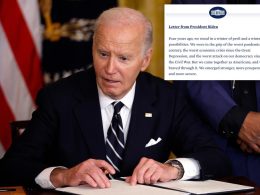President Biden said on Friday that he believes the Equal Rights Amendment met the requirements of ratification as the 28th Amendment to the Constitution. But his remarks were likely symbolic, as he declined to order the government to finalize the process by officially publishing it, a move that could invite legal challenges.
Under the Constitution, Mr. Biden does not have a direct role in approving amendments. Colleen Shogan, the national archivist, said last month that she could not certify the amendment “due to established legal, judicial and procedural decisions.”
The amendment would guarantee equality for women, improving pay equity, strengthening domestic violence and sexual harassment protections and blocking discrimination against pregnant people. Over the years, conservative activists who were opposed to the amendment argued that it could lead to a constitutional right to abortion.
The amendment has been ratified in 38 states, meeting the requirement that it receive ratification in three-quarters of state legislatures before becoming part of the Constitution.
But opponents say that did not happen within a deadline set by Congress, and they note that several of the 38 states have since moved to withdraw their ratification.
Here are some of the key dates in the amendment’s history.
1923
The Equal Rights Amendment was first introduced in Congress after being written by the suffragist Alice Paul, a social worker and lawyer who had helped push through the 19th Amendment that allowed women to vote. “Men and women shall have equal rights throughout the United States and every place subject to its jurisdiction,” the proposed amendment read.
1971
The amendment was introduced in every session of Congress for decades. After a roughly 50-year gap, it was overwhelmingly approved in the House by a vote of 354-24.
Following the House’s lead, the Senate approved the amendment by a similarly wide margin, 84-8. “Equality of rights under the law shall not be denied or abridged by the United States or by any state on account of sex,” the amendment read. “The Congress shall have the power to enforce, by appropriate legislation, the provisions of this article.”
Lawmakers said that the law needed to be ratified by 38 states within seven years, a deadline later extended to 1982 by President Jimmy Carter.
The topic became the subject of intense legislative fights and political campaigns. Phyllis Schlafly, an anti-feminist leader, created STOP ERA, a movement against the ratification of the amendment. Ms. Schlafly argued that it would counter traditional gender roles by forcing women to serve in combat, among other consequences. Her work helped to slow progress toward ratification in state legislatures.
2017
Decades after the expiration of the initial seven-year deadline for ratification, Nevada became the 36th state to approve the amendment, generating new momentum toward the 38-state mark. A year later, Illinois passed it, leaving the amendment one state shy of the threshold.
2020
Virginia became the 38th state to ratify the amendment, allowing it to clear the threshold. Women packed the galleries of the State Capitol in Richmond during the debate, some wearing sashes that read, “Equal rights for women.”
Under President Donald J. Trump, the Official of Legal Counsel said that year that because the law was not ratified by the congressional deadline, it had “expired and is no longer pending before the states.” The memo noted that five states that had approved the amendment later tried to back out.
Senator Kirsten Gillibrand of New York and Representative Cori Bush of Missouri, both Democrats, introduced a joint resolution stating that the measure had already been ratified and was enforceable as the 28th Amendment. The same year, Senate Republicans blocked a resolution that sought to remove the expired deadline for states to ratify the amendment.
2024
As Ms. Gillibrand continued lobbying White House officials, more than 100 Democratic lawmakers called on Mr. Biden to act on the amendment before leaving office.
In a statement, Dr. Shogan, the national archivist, and her deputy, William J. Bosanko, cited court decisions at the district and circuit levels, as well as Justice Department memos, to argue that they “cannot legally publish the Equal Rights Amendment.”
During her confirmation process in 2022, Dr. Shogan said that she would not add the amendment to the Constitution, leaving the decision to Congress or the federal judiciary.








